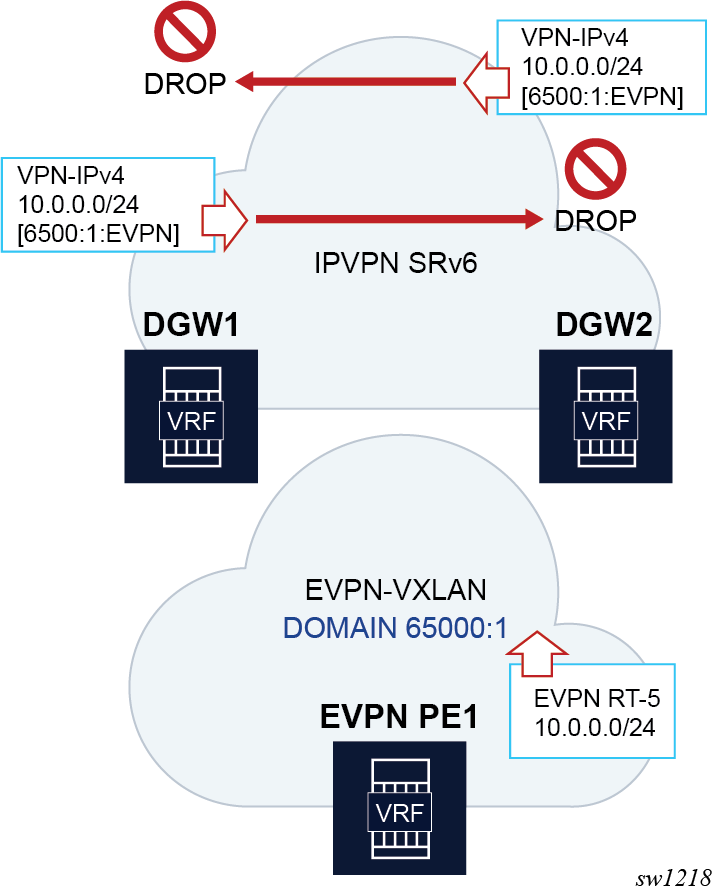The example in the following figure shows a typical Layer 3 EVPN DC gateway scenario where EVPN-IFF routes are translated into IPVPN routes, and vice versa. Because redundant gateways are used, this scenario is subject to Layer 3 routing loops, and the D-PATH attribute helps preventing these loops in an automatic way, without the need for extra routing policies to tag or drop routes.

The following is the configuration of the VPRN or R-VPLS services in DGW1 and DGW2 in the preceding figure.
A:DGW1# configure service vprn 20
A:DGW1>config>service>vprn# info
----------------------------------------------
interface "sbd-1" create
vpls “sbd-1”
evpn-tunnel
exit
exit
segment-routing-v6 1 create
locator "LOC-1"
function
end-dt46
exit
exit
exit
bgp-ipvpn
segment-routing-v6
route-distinguisher 192.0.2.1:20
srv6-instance 1 default-locator "LOC-1"
source-address 2001:db8::1
vrf-target target:64500:20
domain-id 65000:2
no shutdown
exit
exit
no shutdown
*A:DGW1# configure service vpls "sbd-1"
*A:DGW1>config>service>vpls# info
----------------------------------------------
allow-ip-int-bind
exit
vxlan instance 1 vni 1 create
exit
bgp
exit
bgp-evpn
evi 1
ip-route-advertisement domain-id 65000:1
vxlan bgp 1 vxlan-instance 1
no shutdown
exit
exit
stp
shutdown
exit
A:DGW2# configure service vprn 20
A:DGW2>config>service>vprn# info
----------------------------------------------
interface "sbd-1" create
vpls “sbd-1”
evpn-tunnel
exit
exit
segment-routing-v6 1 create
locator "LOC-1"
function
end-dt46
exit
exit
exit
bgp-ipvpn
segment-routing-v6
route-distinguisher 192.0.2.2:20
srv6-instance 1 default-locator "LOC-1"
source-address 2001:db8::2
vrf-target target:64500:20
domain-id 65000:2
no shutdown
exit
exit
no shutdown
*A:DGW2# configure service vpls "sbd-1"
*A:DGW2>config>service>vpls# info
----------------------------------------------
allow-ip-int-bind
exit
vxlan instance 1 vni 1 create
exit
bgp
exit
bgp-evpn
evi 1
ip-route-advertisement domain-id 65000:1
vxlan bgp 1 vxlan-instance 1
no shutdown
exit
exit
stp
shutdown
exit
The following considerations apply to the example configuration shown in Figure: Use of D-PATH for Layer 3 DC gateway redundancy.
- Imported VPN-IP SRv6 routes are readvertised as EVPN-IFF VXLAN routes with a prepended D-PATH domain 65000:2:128.
- Imported EVPN-IFF VXLAN routes are readvertised as VPN-IP SRv6 routes with a prepended D-PATH domain 65000:1:70.
If PE1 sends an EVPN-IFF route 10.0.0.0/24 that is imported by both DGW1 and DGW2, then, when DGW1 and DGW2 receive each other’s routes, they identify the D-PATH attribute and compare the list of domains with the locally configured domains in the VPRN. Since the domain matches one of the local domains, the route is not installed in the VPRN route table and it is flagged as a looped route (the show router bgp routes detail or hunt commands show DPath Loop VRFs: 20). In this way loops are prevented.